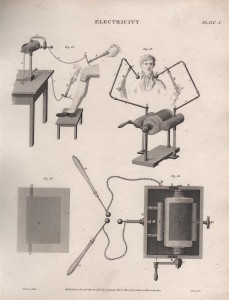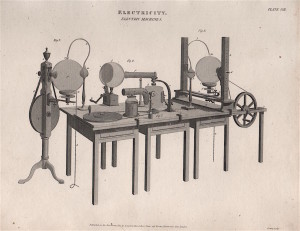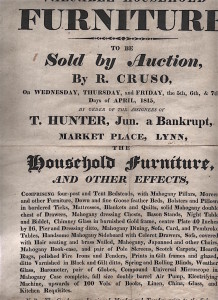Discovered on a stall in Portobello Road is this fascinating auction poster of 1815 announcing the forthcoming sale of household furniture and effects that once belonged to a bankrupt called T. Hunter. Research in Norfolk County Record Office produced nothing about Mr Hunter, although I was luckier with Robert Cruso, who was a prominent King’s Lynn auctioneer at this time. Indeed his name is preserved in the present firm of valuers and surveyors, Cruso and Wilkin of King’s Lynn, which was established in 1756 and now claims to be one of the oldest auction houses in the UK.
However, the auctioneer and his unusual name aren’t the only features that stand out in this poster. Some of items listed for sale are unusual, to say the least. Among the usual mirrors, chests of drawers and pictures can be found a ‘compound universal microscope in mahogany case complete’, a ‘full size double barrel Air Pump’, and most intriguing of all, an ‘Electrifying Machine’. These items prompt the questions; who exactly was T. Hunter, and what was he was doing with these scientific instruments?

Doubtless, Hunter was a wealthy amateur who, if he had bought these three items new, was decidedly serious about investigating the working of nature. The late eighteenth century was a boom time for scientific discovery and we should appreciate that most scientific researchers were amateurs in the true sense of that word—that is, they held no academic posts, and if they were, say physicians, they pursued their research independently of their chosen profession. Hunter could have been someone similar to that central figure in the famous painting of the 1768 by Joseph Wright of Derby, ‘The Air Pump’. This amateur ‘natural philosopher ‘whose experiment with a trapped bird in the pump so entranced members of his family, would also have owned a microscope of some kind. He would not, however, have possessed an ‘Electrifying Machine’ at that time. This apparatus became popular after the Italian Luigi Galvani experimented with the effects of electricity in the early 1780s.

Galvani showed that a small charge of static electricity passed through the sciatic nerve of a dead frog would cause its limb to jerk into life. Before long the demonstration of ‘Galvanism ‘became a craze and ‘Electrifying Machines’ were manufactured both as medical aids and as novelties to be demonstrated at trendy Galvanic parties. Mary Shelley was so intrigued by Galvanism that she introduced the phenomenon into her horror masterpiece Frankenstein, where the monster is brought to life by a massive charge of electricity.
The accompanying two images are dated 1812 and 1818. Interestingly, the latter, which shows the practical application of the electrifying machine, was published in the very year that Frankenstein appeared. [R.M.H.]


London Gazette of 26/9/1815 (No.17065, p.1986*) gives notice of a meeting of the creditors of “Thomas Hunter the younger, of King’s Lynn, […] Woollen-Draper and Taylor, Dealer and Chapman”, declared bankrupt in February of that year; they planned to “make a dividend of the estate”. If it were that T.Hunter, given his trade it might be hard to show whether he was the experimenter himself or had just bought the goods from an earlier owner. [*With thanks to Google Books and the University of Iowa!]